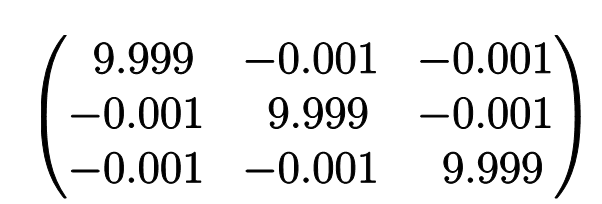目標
普通にnumpyのndarrayをprintすると
[[ 9.999e+00 -1.000e-03 -1.000e-03]
[-1.000e-03 9.999e+00 -1.000e-03]
[-1.000e-03 -1.000e-03 9.999e+00]]
のようになる。
このndarrayをlatexでコンパイルできる形に出力させたい。
つまり、このndarrayを与えれば、
\begin{pmatrix}
\ 9.999 & -0.001 & -0.001 \\
-0.001 & \ 9.999 & -0.001 \\
-0.001 & -0.001 & \ 9.999 \\
\end{pmatrix}
みたいな出力をする関数を作る。こればあれば
ができる
\documentclass[12pt]{article}
\usepackage{amsmath}
\begin{document}
\begin{align*}
\begin{pmatrix}
\ 9.999 & -0.001 & -0.001 \\
-0.001 & \ 9.999 & -0.001 \\
-0.001 & -0.001 & \ 9.999 \\
\end{pmatrix}
\end{align*}
\end{document}
作り方
まず、行列の行数と列の数は、numpy.array.shapeでtupleとして取得できる。
tupleに(行数、列数)として入っているのでこれをそれぞれ変数に入れる。
5. データ構造 — Python 3.8.5 ドキュメント
import numpy as np
matrix = np.ones((3,3))
_, max_column = matrix.shape
今回は行数は使わないので、使わないという意味を込めて_と言う変数として書いた。
作った関数
def str_2dmatrix_latex(matrix, indent=4, digit=3, env="pmatrix"):
r"""
Convert 2d matrix to str for latex.
*In your latex preset, you must add
amsmath
Parameters
----------
matrix : numpy.ndarray
2d matrix
indent : int
indent width
if indent is -1, indent become tab
digit : int
digit=2 0.11
digit=3 0.111
env : str
env is inserted ... in \begin{...}
and \end{...}
Return
------
str
"""
_, max_column = matrix.shape
if indent == -1:
str_indent = "\t"
else:
str_indent = " " * indent
list_str = []
list_str.append(r"\begin{" + f"{env}" + "}\n")
for row in matrix:
for j, elem in enumerate(row):
str_elem = f"{elem:.{digit}f}"
# format
if elem > 0:
str_elem = r"\ " + str_elem
# write matrix element
if j == 0:
list_str.append(str_indent + str_elem + " & ")
elif j == max_column - 1:
list_str.append(str_elem + r" \\" + "\n")
else:
list_str.append(str_elem + " & ")
list_str.append(r"\end{" + f"{env}" + "}\n")
return "".join(list_str)
def main():
one_mat = np.ones((3, 3))
"""
1 1 1
1 1 1
1 1 1
"""
id_mat = np.eye(3)
"""
1 0 0
0 1 0
0 0 1
"""
mat = 10 * id_mat - 0.001 * one_mat
print(str_2dmatrix_latex(mat))
if __name__ == "__main__":
main()
実行結果
\begin{pmatrix}
\ 9.999 & -0.001 & -0.001 \\
-0.001 & \ 9.999 & -0.001 \\
-0.001 & -0.001 & \ 9.999 \\
\end{pmatrix}
